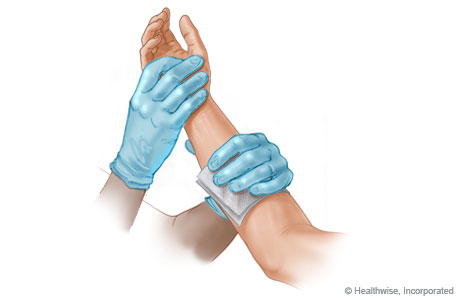Wound check in children: Overview
Children have wounds that need care for many reasons. Your child may have a cut that needs care after surgery. Your child may have a cut, scrape, or puncture wound from an accident. Or your child may have a wound because of a boil or an abscess.
Whatever the cause of the wound, there are things you can do to care for it at home.
The doctor may also want your child to come back for a wound check. The wound check lets the doctor know how your child's wound is healing and if your child needs more treatment.
Wound care: When to call
Call your doctor now or seek immediate medical care if:
- You have new pain, or the pain gets worse.
- The skin near the wound is cold or pale or changes color.
- You have tingling, weakness, or numbness near the wound.
- The wound starts to bleed, and blood soaks through the bandage. Oozing small amounts of blood is normal.
- You have symptoms of infection, such as:
- Increased pain, swelling, warmth, or redness.
- Red streaks leading from the wound.
- Pus draining from the wound.
- A fever.
Watch closely for changes in your health, and be sure to contact your doctor if:
- You do not get better as expected.
How to stop bleeding from a skin wound

If emergency treatment is not needed, bleeding can usually be stopped by applying steady, direct pressure and elevating the wound. The following steps will protect the skin wound and protect you from exposure to another person's blood.
Before you try to stop the bleeding:
- Wash your hands well with soap and water, if available.
- Put on medical gloves, if available, before applying direct pressure to the wound. If gloves are not available, use many layers of clean cloth, plastic bags, or the cleanest material available between your hands and the wound.
- Have the injured person hold direct pressure on the wound, if possible, and elevate the injured area.
- Use your bare hands to apply direct pressure only as a last resort.
To stop the bleeding:
- Have the injured person lie down and elevate the site that is bleeding.
- Remove any visible objects in the wound that are easy to remove. Control the bleeding before trying to clean the wound.
- Remove or cut clothing from around the wound. Remove any jewelry from the general area of the wound so if the area swells, the jewelry will not affect blood flow.
- Apply steady, direct pressure and elevate the area for a full 15 minutes. Use a clock—15 minutes can seem like a long time. Resist the urge to peek after a few minutes to see whether bleeding has stopped. If blood soaks through the cloth, apply another one without lifting the first. If there is an object in the wound, apply pressure around the object, not directly over it.
- If moderate to severe bleeding has not slowed or stopped, continue direct pressure while getting help. Do not use a tourniquet to stop the bleeding. Do all you can to keep the wound clean and avoid further injury to the area.
Mild bleeding usually stops on its own or slows to an ooze or trickle after 15 minutes of pressure. It may ooze or trickle for up to 45 minutes.
Occasionally a puncture wound causes bleeding underneath the skin, but only a small amount of blood comes out of the wound. When this happens, the area around the puncture wound may become swollen and bruised. If the bleeding causes blood to collect in the wound site (wound hematoma), the risk of an infection increases.
While following the steps to stop the bleeding, watch for signs of shock in the injured person, including:
- Passing out (losing consciousness).
- Feeling very dizzy or lightheaded, like the person may pass out.
- Feeling very weak or having trouble standing up.
- Being less alert. The person may suddenly be unable to respond to questions, or they may be confused, restless, or fearful.
©2011-2024 Healthwise, Incorporated